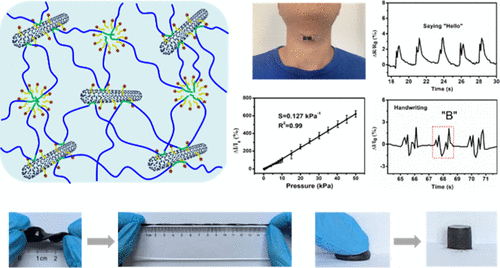当前位置:
X-MOL 学术
›
ACS Appl. Mater. Interfaces
›
论文详情
Our official English website, www.x-mol.net, welcomes your
feedback! (Note: you will need to create a separate account there.)
Carbon Nanotubes/Hydrophobically Associated Hydrogels as Ultrastretchable, Highly Sensitive, Stable Strain, and Pressure Sensors.
ACS Applied Materials & Interfaces ( IF 8.3 ) Pub Date : 2020-01-17 , DOI: 10.1021/acsami.9b21659 Zhihui Qin 1 , Xia Sun 1 , Qingyu Yu 1 , Haitao Zhang 1 , Xiaojun Wu 1 , Mengmeng Yao 1 , Wenwen Liu 1 , Fanglian Yao 1, 2, 3 , Junjie Li 1, 3
ACS Applied Materials & Interfaces ( IF 8.3 ) Pub Date : 2020-01-17 , DOI: 10.1021/acsami.9b21659 Zhihui Qin 1 , Xia Sun 1 , Qingyu Yu 1 , Haitao Zhang 1 , Xiaojun Wu 1 , Mengmeng Yao 1 , Wenwen Liu 1 , Fanglian Yao 1, 2, 3 , Junjie Li 1, 3
Affiliation

|
Conductive hydrogels have become one of the most promising materials for skin-like sensors because of their excellent biocompatibility and mechanical flexibility. However, the limited stretchability, low toughness, and fatigue resistance lead to a narrow sensing region and insufficient durability of the hydrogel-based sensors. In this work, an extremely stretchable, highly tough, and anti-fatigue conductive nanocomposite hydrogel is prepared by integrating hydrophobic carbon nanotubes (CNTs) into hydrophobically associated polyacrylamide (HAPAAm) hydrogel. In this conductive hydrogel, amphiphilic sodium dodecyl sulfate was used to ensure uniform dispersion of CNTs in the hydrogel network, and hydrophobic interactions between the hydrogel matrix and the CNT surface formed, greatly improving the mechanical properties of the hydrogel. The obtained CNTs/HAPAAm hydrogel showed excellent stretchability (ca. 3000%), toughness (3.42 MJ m-3), and great anti-fatigue property. Moreover, it exhibits both high tensile strain sensitivity in the wide strain ranges (gauge factor = 4.32, up to 1000%) and high linear sensitivity (0.127 kPa-1) in a large-pressure region within 0-50 kPa. The CNTs/HAPAAm hydrogel-based sensors can sensitively and stably detect full-range human activities (e.g., elbow rotation, finger bending, swallowing motion, and pronouncing) and handwriting, demonstrating the CNTs/HAPAAm hydrogel's potential as the wearable strain and pressure sensors for flexible devices.
中文翻译:

碳纳米管/疏水相关的水凝胶,作为可超伸,高灵敏,稳定的应变和压力传感器。
导电水凝胶具有出色的生物相容性和机械柔韧性,已成为皮肤传感器最有前途的材料之一。然而,有限的拉伸性,低韧性和耐疲劳性导致水凝胶基传感器的感测区域狭窄和耐久性不足。在这项工作中,通过将疏水性碳纳米管(CNT)集成到疏水缔合的聚丙烯酰胺(HAPAAm)水凝胶中,制备了具有极高可拉伸性,高韧性和抗疲劳性的导电纳米复合水凝胶。在该导电水凝胶中,使用两亲十二烷基硫酸钠来确保CNT在水凝胶网络中的均匀分散,并且在水凝胶基质与CNT表面之间形成疏水相互作用,从而大大改善了水凝胶的机械性能。所得的CNT / HAPAAm水凝胶显示出优异的拉伸性(约3000%),韧性(3.42MJ·m-3)和优异的抗疲劳性。此外,它在宽应变范围(应变系数= 4.32,最高1000%)中显示出高拉伸应变敏感性,在0-50 kPa内的大压力区域中显示出高线性敏感性(0.127 kPa-1)。基于CNTs / HAPAAm水凝胶的传感器可以灵敏,稳定地检测人体的全方位活动(例如,肘部旋转,手指弯曲,吞咽运动和发音)和手写,证明了CNTs / HAPAAm水凝胶作为可穿戴应变和压力传感器的潜力用于柔性设备。它在宽应变范围内(应变系数= 4.32,最高1000%)既显示出高拉伸应变敏感性,又在0-50 kPa内的大压力范围内显示出高线性敏感性(0.127 kPa-1)。基于CNTs / HAPAAm水凝胶的传感器可以灵敏,稳定地检测人体的全方位活动(例如,肘部旋转,手指弯曲,吞咽运动和发音)和手写,证明了CNTs / HAPAAm水凝胶作为可穿戴应变和压力传感器的潜力用于柔性设备。它在宽应变范围内(应变系数= 4.32,最高1000%)既显示出高拉伸应变敏感性,又在0-50 kPa内的大压力范围内显示出高线性敏感性(0.127 kPa-1)。基于CNTs / HAPAAm水凝胶的传感器可以灵敏,稳定地检测人体的全方位活动(例如,肘部旋转,手指弯曲,吞咽运动和发音)和手写,证明了CNTs / HAPAAm水凝胶作为可穿戴应变和压力传感器的潜力用于柔性设备。
更新日期:2020-01-17
中文翻译:

碳纳米管/疏水相关的水凝胶,作为可超伸,高灵敏,稳定的应变和压力传感器。
导电水凝胶具有出色的生物相容性和机械柔韧性,已成为皮肤传感器最有前途的材料之一。然而,有限的拉伸性,低韧性和耐疲劳性导致水凝胶基传感器的感测区域狭窄和耐久性不足。在这项工作中,通过将疏水性碳纳米管(CNT)集成到疏水缔合的聚丙烯酰胺(HAPAAm)水凝胶中,制备了具有极高可拉伸性,高韧性和抗疲劳性的导电纳米复合水凝胶。在该导电水凝胶中,使用两亲十二烷基硫酸钠来确保CNT在水凝胶网络中的均匀分散,并且在水凝胶基质与CNT表面之间形成疏水相互作用,从而大大改善了水凝胶的机械性能。所得的CNT / HAPAAm水凝胶显示出优异的拉伸性(约3000%),韧性(3.42MJ·m-3)和优异的抗疲劳性。此外,它在宽应变范围(应变系数= 4.32,最高1000%)中显示出高拉伸应变敏感性,在0-50 kPa内的大压力区域中显示出高线性敏感性(0.127 kPa-1)。基于CNTs / HAPAAm水凝胶的传感器可以灵敏,稳定地检测人体的全方位活动(例如,肘部旋转,手指弯曲,吞咽运动和发音)和手写,证明了CNTs / HAPAAm水凝胶作为可穿戴应变和压力传感器的潜力用于柔性设备。它在宽应变范围内(应变系数= 4.32,最高1000%)既显示出高拉伸应变敏感性,又在0-50 kPa内的大压力范围内显示出高线性敏感性(0.127 kPa-1)。基于CNTs / HAPAAm水凝胶的传感器可以灵敏,稳定地检测人体的全方位活动(例如,肘部旋转,手指弯曲,吞咽运动和发音)和手写,证明了CNTs / HAPAAm水凝胶作为可穿戴应变和压力传感器的潜力用于柔性设备。它在宽应变范围内(应变系数= 4.32,最高1000%)既显示出高拉伸应变敏感性,又在0-50 kPa内的大压力范围内显示出高线性敏感性(0.127 kPa-1)。基于CNTs / HAPAAm水凝胶的传感器可以灵敏,稳定地检测人体的全方位活动(例如,肘部旋转,手指弯曲,吞咽运动和发音)和手写,证明了CNTs / HAPAAm水凝胶作为可穿戴应变和压力传感器的潜力用于柔性设备。











































 京公网安备 11010802027423号
京公网安备 11010802027423号